How a butterfly can help you become a better putter


What does a butterfly have to do with putting? The answer is nothing. Except for, it can help you become a better putter, and here is how! Most people think putting is utterly boring. The only thing fun about it is if you hole a putt that you didn’t expect to go in. Of course, everyone knows of the importance of putting in the game of golf, and all golfers know they should probably practice their putting more than they do. But again, it’s just no fun. Almost like that calculus test you had to take or learning vocabulary for your Spanish test. Studying for a test like that becomes strenuous and chances are, you will put off studying for as long as you can. Welcome to the world of procrastination. The same principle can be applied to putting. But don’t worry, there are ways to change that and to introduce fun to the equation.
Human learning is something that has occupied scientists for decades. Finding out how to enhance human learning is a key objective and something that becomes more and more important in our modern world. One thing experts can agree on, however, is that humans learn better the more senses are involved in the process. Take for example that Spanish vocabulary test you are trying to study for. If you read the word ‘mariposa’ and the translation butterfly, it probably won’t mean anything to you while you are sitting at your desk with your Spanish book. Even while you try to hammer the word into your brain, the butterfly will not come to life and you run dangerously close to not being able to remember the word during your test the next day. However, if you decide to go outside and sit on a field, smelling the fresh air, hearing the birds sing, and seeing an actual butterfly pass by while you say out loud ‘una mariposa’, then your chances have increased significantly that you will be able to remember that word. The scenario sounds a little cheesy, but it is exactly how your brain works. You have created a surrounding for yourself, that sticks out and the next time you are quizzed on what butterfly means in Spanish, you will remember how you sat on that field while the butterfly passed by, and the word was ‘una mariposa’. It’s also the reason why books for little kids often have sounds in combination with feel elements. They see a monkey, hear its voice, and can feel how the fur feels like. That way their brains can form a connection between the senses and the next time they hear a monkey, they will be able to visualize how he looks like and remember the feel of its fur.
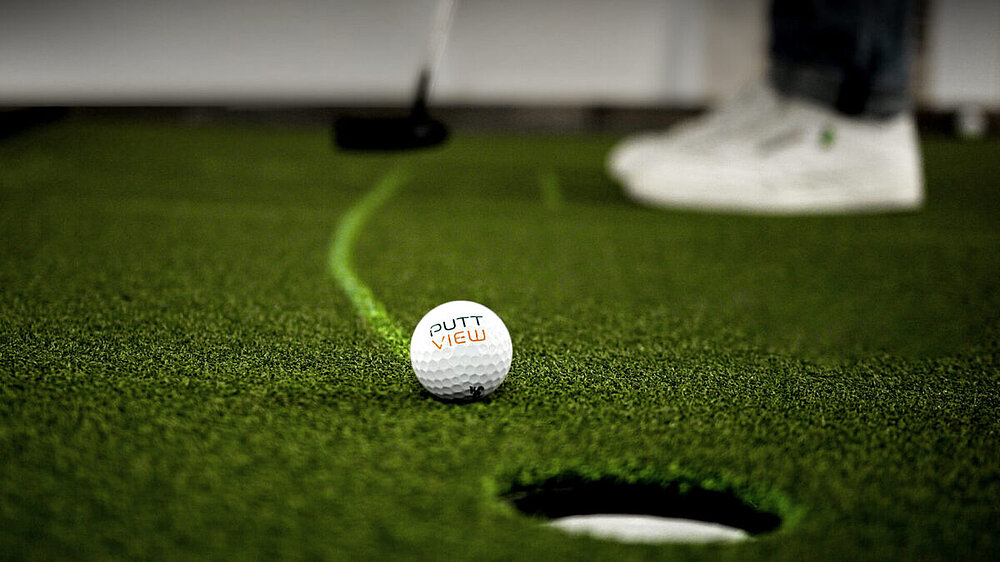
Creating memories that last a life-time
But how does that apply to putting, you might ask? Well, putting is a very tricky thing in terms of learning. While the objective is clear, namely getting the ball into the hole, the ground rules are difficult to grasp. There is nothing there to feel, you cannot smell a putt and the only way of seeing the line of your putt is through imagination. Before getting more into that, we will have to discuss a different way humans learn. And that is through experience and feedback. This can be positive and negative reinforcement. Chances are, that if you have ever touched a hot stove with your bare hands, you have learned your lesson for the rest of your life. It quite literally has burned into your brain. And, if you go through your personal experiences and things that you are still able to remember even after a very long time, you will find, that those memories all have something in common: They are either connected with emotions, or they somehow stuck out from the rest of your experiences. For example, because you were having an exceptional amount of fun while you were doing a task, or because you won a trophy, beat a fellow competitor, or did something, that you have never thought you could do.
Going back to putting, all of us probably remember specific putts, that went into the hole. Most likely it was an important putt for your round or tournament. It meant something to you to make that putt. Or maybe, you can remember a round, where all putts seemed to drop. In general, this type of experience is primed to form a behavioral pattern that would lead you to want more. The gratification you feel during those moments is highly addictive and you would want to make sure, that you get that feeling more often.
The only way to make sure you will be able to achieve that is through practice. Yet, no matter how often you get off the course, frustrated or happy, most of the time it doesn’t lead you to the putting green. But, if the things we have established above are true, then why are we still so reluctant to practice our putting? Obviously, learning takes place, every time you hit a putt. If it is too short, you will try to hit it a little harder the next time. If you underread the break, you might aim a little further outside the next time you encounter a similar break. And, if you watch someone putt way past the hole, chances are that you will leave your putt short. Based on the feedback you are getting from your surroundings; your brain builds a blueprint of the motion it thinks you should be doing.
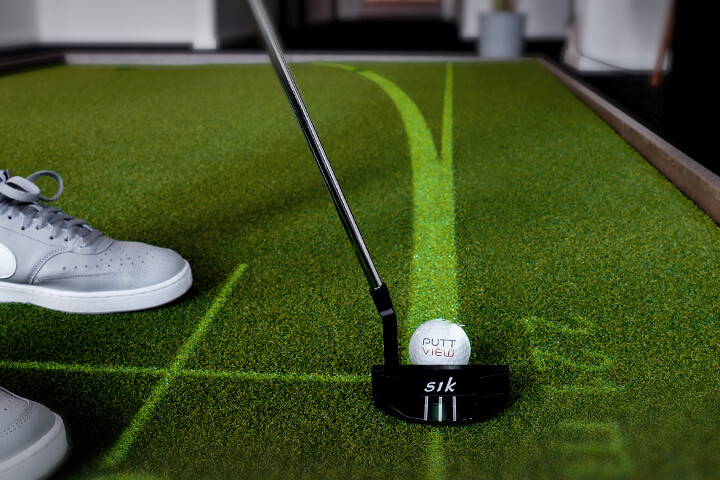
However, learning solely on feedback that sometimes is, and sometimes isn’t accurate, is something that you perceive as boring. You quickly realize what you are trying to learn is an impossible task, as you are lacking the important parameters of a putt and feel like it’s purely by chance that your ball goes into the hole. Therefore, even if you are happy to hole out a putt, you do not necessarily know how to replicate it. This is one of the reasons why PuttView is an incredibly valuable tool in terms of putting practice. By projecting the parameters of the putt onto the green, you are able to learn by just looking at the visual feedback. Seeing the exact path of your putt, helps your brain to appreciate break better, even without putting the putt. Most people tend to underappreciate the amount of break, leaving their balls short and below the hole, therefore the experience of seeing the exact and actual path of the ball is often eye-opening and creates a lasting memory. Furthermore, the transfer to the course will be immediate as well, as moving forward, your brain will remember just how bad it underestimated the amount of break, and you will adjust accordingly.
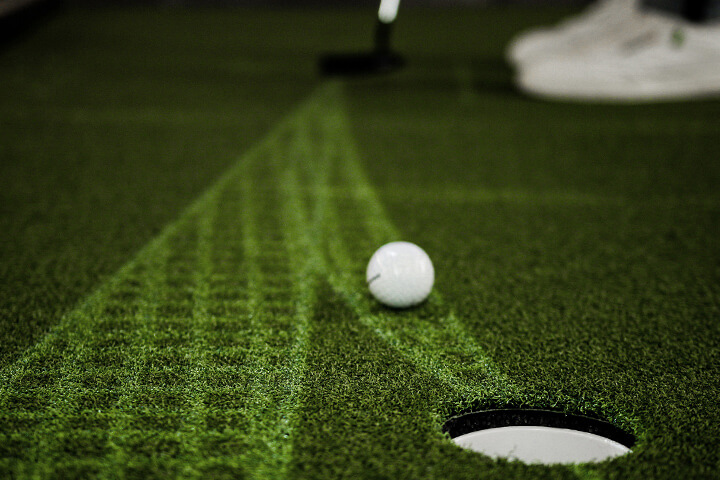
As a visual feedback tool, PuttView can be helpful in many ways. We have just established, that looking at the projection will increase your learning process significantly, but you can add yet another layer to it. By aligning yourself to the projection, adding the visual cues that feed into your way of imagining your putt, and attempting to hit the putt, you are also adding a sensory aspect to the equation. It is basically like you are sitting on that field again and a butterfly is passing by, or like feeling the monkey’s fur while hearing its voice. By experiencing the putt, your brain forms a connection between what you see, how it feels to you, and the real-time ball tracking gives you the necessary information on why your ball might not have gone into the hole. Just like that, your brain has parameters that will help to create lasting memories. Instead of guessing, you now have knowledge of what you are trying to accomplish on the green and your brain can replicate the memories it has created. And the good news is, this comes with no conscious effort from your side. Your brain picks up those cues, without you actually trying to learn.
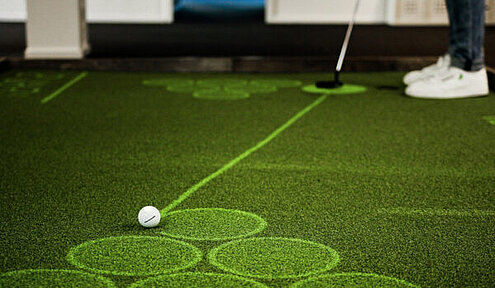
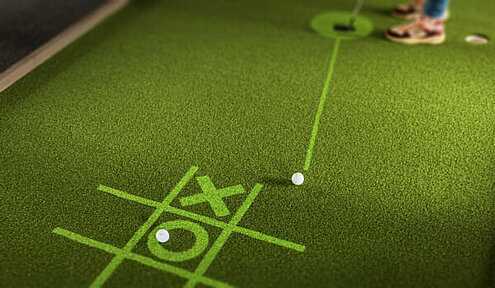
Yet, simply putting along some visual lines will not do the trick in the long run. While you will inevitably learn from hitting putts on a PuttView green, we are still lacking the emotional side of learning. Therefore, PuttView also offers a wide range of interactive tools and features. Gamification is a commonly used term in that respect. Per definition it is the application of typical elements of game playing (e.g. point scoring, competition with others, rules of play) to other areas of activity, to encourage engagement with a product or service. By being able to adjust and control the visual support PuttView offers, the player is enabled to create a learning environment that fits their needs. You can animate the Ideal Line, choose various drills such as the Hole-out-Challenge, play games like PuttPong or Tic-Tac-Toe, or simply change your putting position to anywhere on the green. This level of engagement keeps your brain from tuning out and it keeps it interested in what might come next.
Creating the right learning environment for yourself is essential to any type of progress, not only to putting or golf in general. If you fail to establish it, chances are that you will eventually quit whatever it is you were trying to learn. Either because you are bored out of your mind, or you get frustrated and lose interest in pursuing a specific task. As mentioned above, putting is no different from that, and being able to make it more fun, is something you should strive for. A player should always know, what type of learner he or she is. Some people learn better if they keep score, create challenges for themselves or play against someone. Others prefer to rely on their senses and by forming memories, they are able to replicate a motion that works even under immense pressure. Either way, it is important to keep your brain engaged in the process. And yes, this can be achieved solely by playing games like PuttPong. Those games teach you essential skills such as matching your intended speed with the right line or being able to deliver under pressure. Making learning fun, engaging and successful. Because even if you haven’t learned anything while reading this blog, you now know that ‘una mariposa’ means butterfly in Spanish. Funny, how learning works, right?